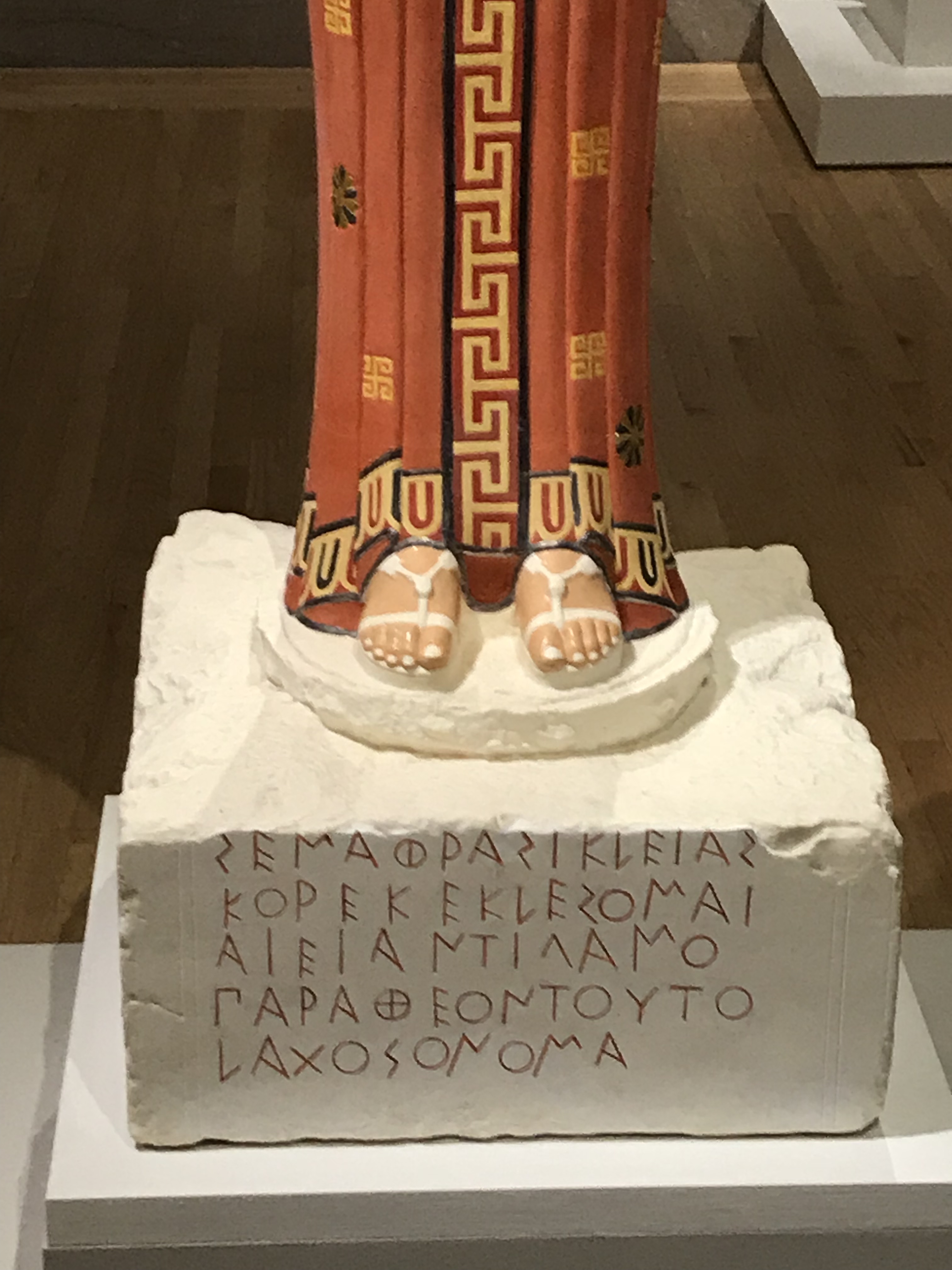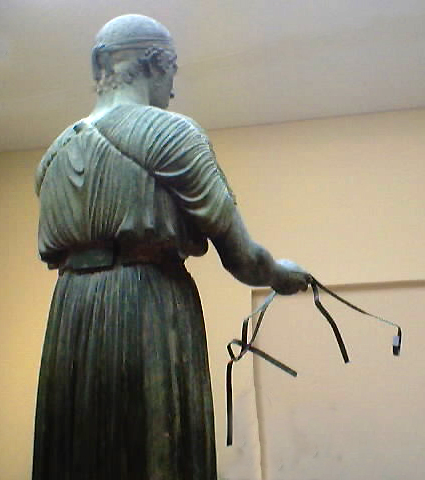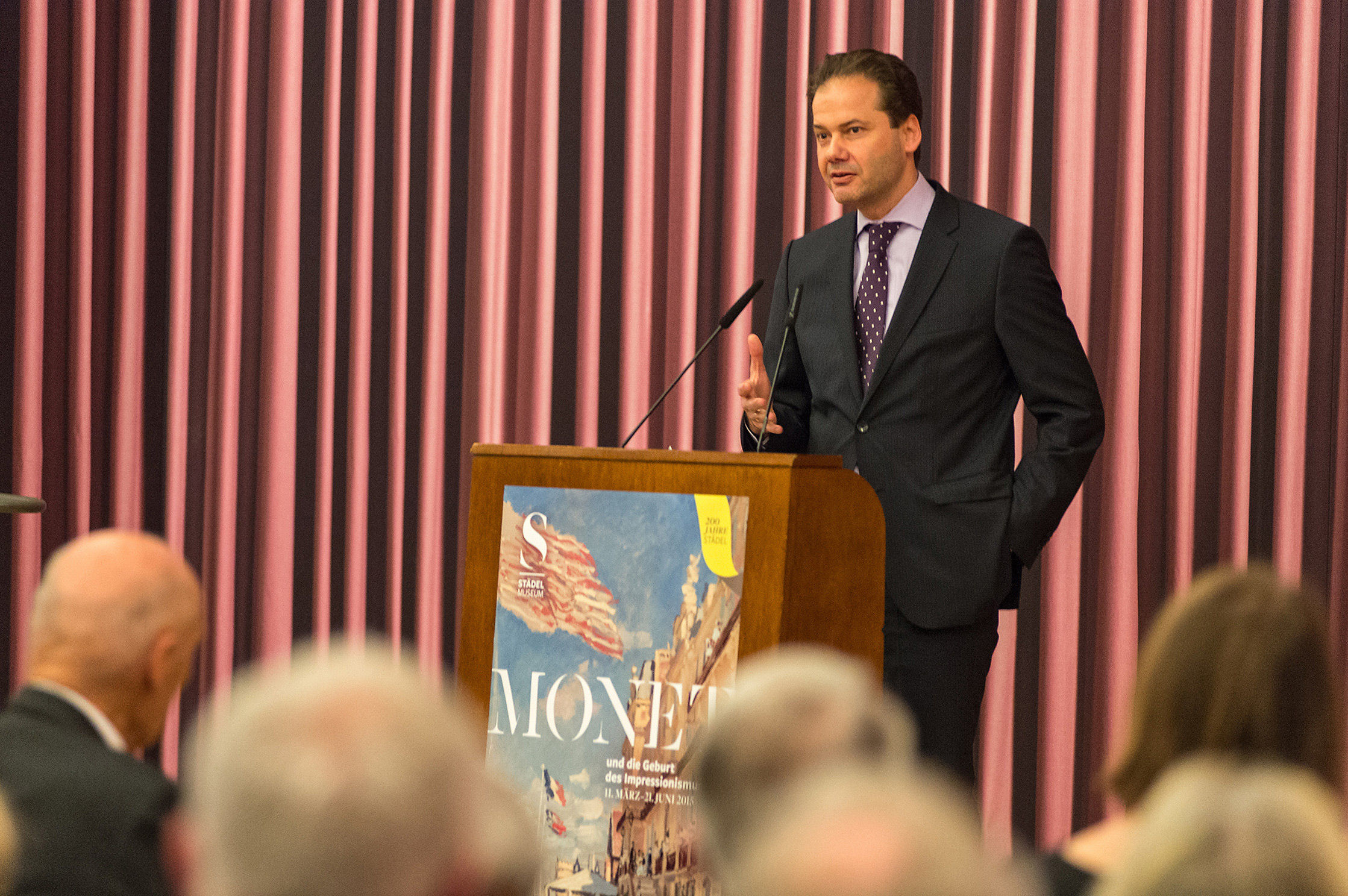|
Phrasikleia Kore
The Phrasikleia Kore is an Archaic Greek funerary statue by the artist Aristion of Paros, created between 550 and 540 BCE. It was found carefully buried in the ancient city of Myrrhinous (modern Merenta) in Attica and excavated in 1972. The exceptional preservation of the statue and the intact nature of the polychromy elements makes the Phrasikleia Kore one of the most important works of Archaic art.Stieber, Mary C. The Poetics of Appearance in the Attic Korai. 1st ed. Austin: University of Texas Press, 2004. p. 1. History The Phrasikleia and the Attic ''korai'' are the most well-preserved statues in existence from the 6th century BCE. They represent a type of Archaic female statue intended specifically for funerary use.Stieber, Mary C. The Poetics of Appearance in the Attic Korai. 1st ed. Austin: University of Texas Press, 2004. p. 141. The Phrasikleia Kore is a Parian marble statue that features prominent polychromy as seen in the hair and the dress. It is thought that the skin ... [...More Info...] [...Related Items...] OR: [Wikipedia] [Google] [Baidu] |
Korai
Kore (Greek: κόρη "maiden"; plural korai) is the modern term given to a type of free-standing ancient Greek sculpture of the Archaic period depicting female figures, always of a young age. Kouroi are the youthful male equivalent of kore statues. Korai show the restrained " archaic smile", which did not demonstrate emotion. It was the symbol of the ideal, transcending above the hardships of the world. Unlike the nude kouroi, korai are depicted in thick and sometimes elaborate drapery. As fashions changed, so did the type of clothing they wore. Over time, korai went from the heavy peplos to lighter garments such as the chiton. Their posture is rigid and column-like, sometimes with an extended arm. Some korai were painted colorfully to enhance the visual impact of the garments and for narrative purposes. There are multiple theories on whether the korai represent mortals or deities. Korai also functioned as offerings to the deities or the dead ... [...More Info...] [...Related Items...] OR: [Wikipedia] [Google] [Baidu] |
National Archaeological Museum Of Athens
The National Archaeological Museum ( el, Εθνικό Αρχαιολογικό Μουσείο) in Athens houses some of the most important artifacts from a variety of archaeological locations around Greece from prehistory to late antiquity. It is considered one of the greatest museums in the world and contains the richest collection of Greek Antiquity artifacts worldwide. It is situated in the Exarcheia area in central Athens between Epirus Street, Bouboulinas Street and Tositsas Street while its entrance is on the Patission Street adjacent to the historical building of the Athens Polytechnic university. History The first national archaeological museum in Greece was established by the governor of Greece Ioannis Kapodistrias in Aigina in 1829. Subsequently, the archaeological collection was relocated to a number of exhibition places until 1858, when an international architectural competition was announced for the location and the architectural design of the new museum.The Nation ... [...More Info...] [...Related Items...] OR: [Wikipedia] [Google] [Baidu] |
Chiton (garment)
A chiton (Greek: χιτών, ''khitōn'') is a form of tunic that fastens at the shoulder, worn by men and women of ancient Greece and Rome. There are two forms of chiton. One is the Doric chiton and the later Ionic chiton. According to Herodotus, popular legend was that Athenian women began to wear the chiton as opposed to the peplos after several women stabbed a messenger to death with the bronze pins characteristic of the peplos. Etymology The word ''chiton'' is derived from a Central Semitic language *''kittan'' (e.g. Hebrew כֻּתֹּנֶת ''kuttṓnĕṯ''), ultimately from a word for flax. Different forms and wearing styles A shorter version of the chiton was called the chitoniskos. Doric chiton The Doric chiton is a single rectangle of woolen or linen fabric. It can be worn plain or with an overfold called an ''apoptygma'', which is more common to women. It can be draped and fastened at the shoulder by pins (Greek: peronai; Latin: fibulae) or sewing, or by butto ... [...More Info...] [...Related Items...] OR: [Wikipedia] [Google] [Baidu] |
6th-century BC Greek Sculptures
The 6th century is the period from 501 through 600 in line with the Julian calendar. In the West, the century marks the end of Classical Antiquity and the beginning of the Middle Ages. The collapse of the Western Roman Empire late in the previous century left Europe fractured into many small Germanic kingdoms competing fiercely for land and wealth. From the upheaval the Franks rose to prominence and carved out a sizeable domain covering much of modern France and Germany. Meanwhile, the surviving Eastern Roman Empire began to expand under Emperor Justinian, who recaptured North Africa from the Vandals and attempted fully to recover Italy as well, in the hope of reinstating Roman control over the lands once ruled by the Western Roman Empire. In its second Golden Age, the Sassanid Empire reached the peak of its power under Khosrau I in the 6th century.Roberts, J: "History of the World.". Penguin, 1994. The classical Gupta Empire of Northern India, largely overrun by the Huna, ended i ... [...More Info...] [...Related Items...] OR: [Wikipedia] [Google] [Baidu] |
National Archaeological Museum, Athens
The National Archaeological Museum ( el, Εθνικό Αρχαιολογικό Μουσείο) in Athens houses some of the most important artifacts from a variety of archaeological locations around Greece from prehistory to late antiquity. It is considered one of the greatest museums in the world and contains the richest collection of Greek Antiquity artifacts worldwide. It is situated in the Exarcheia area in central Athens between Epirus Street, Bouboulinas Street and Tositsas Street while its entrance is on the Patission Street adjacent to the historical building of the Athens Polytechnic university. History The first national archaeological museum in Greece was established by the governor of Greece Ioannis Kapodistrias in Aigina in 1829. Subsequently, the archaeological collection was relocated to a number of exhibition places until 1858, when an international architectural competition was announced for the location and the architectural design of the new museum.The Nation ... [...More Info...] [...Related Items...] OR: [Wikipedia] [Google] [Baidu] |
Marble Sculptures In Greece
Marble is a metamorphic rock composed of recrystallized carbonate minerals, most commonly calcite or dolomite. Marble is typically not foliated (layered), although there are exceptions. In geology, the term ''marble'' refers to metamorphosed limestone, but its use in stonemasonry more broadly encompasses unmetamorphosed limestone. Marble is commonly used for sculpture and as a building material. Etymology The word "marble" derives from the Ancient Greek (), from (), "crystalline rock, shining stone", perhaps from the verb (), "to flash, sparkle, gleam"; R. S. P. Beekes has suggested that a "Pre-Greek origin is probable". This stem is also the ancestor of the English word "marmoreal," meaning "marble-like." While the English term "marble" resembles the French , most other European languages (with words like "marmoreal") more closely resemble the original Ancient Greek. Physical origins Marble is a rock resulting from metamorphism of sedimentary carbonate rocks, mo ... [...More Info...] [...Related Items...] OR: [Wikipedia] [Google] [Baidu] |
Art Of Ancient Attica
Art is a diverse range of human activity, and resulting product, that involves creative or imaginative talent expressive of technical proficiency, beauty, emotional power, or conceptual ideas. There is no generally agreed definition of what constitutes art, and its interpretation has varied greatly throughout history and across cultures. In the Western tradition, the three classical branches of visual art are painting, sculpture, and architecture. Theatre, dance, and other performing arts, as well as literature, music, film and other media such as interactive media, are included in a broader definition of the arts. Until the 17th century, ''art'' referred to any skill or mastery and was not differentiated from crafts or sciences. In modern usage after the 17th century, where aesthetic considerations are paramount, the fine arts are separated and distinguished from acquired skills in general, such as the decorative or applied arts. The nature of art and related concepts, ... [...More Info...] [...Related Items...] OR: [Wikipedia] [Google] [Baidu] |
Archaic Greek Sculptures
Archaic is a period of time preceding a designated classical period, or something from an older period of time that is also not found or used currently: *List of archaeological periods **Archaic Sumerian language, spoken between 31st - 26th centuries BC in Mesopotamia (Classical Sumerian is from 26th - 23rd centuries BC). ** Archaic Greece **Archaic period in the Americas **Early Dynastic Period of Egypt * Archaic Homo sapiens, people who lived about 300,000 to 30,000 B.P. (this is far earlier than the archaeological definition) * Archaism, speech or writing in a form that is no longer current * Archaic language, one that preserves features that are no longer present in other languages of the same language family *List of archaic musical instruments This is a list of medieval musical instruments as used in European music. List References External links''Zampogne e Ciaramella'' {{DEFAULTSORT:Medieval musical instruments Medieval In the history of Europ ... [...More Info...] [...Related Items...] OR: [Wikipedia] [Google] [Baidu] |
Max Hollein
Max Hollein (born 7 July 1969 in Vienna) is an Austria, Austrian art history, art historian and the current Director of the Metropolitan Museum of Art in New York City. He served as Director and CEO of the Fine Arts Museums of San Francisco from July 2016, until April 2018, the Metropolitan Museum of Art announced that Hollein would become its 10th director.Robin Pogrebin (10 April 2018)The Met Goes Beyond Its Doors to Pick a Leader Who Bridges Art and Technology''New York Times''. Hollein oversaw both the De Young (museum), de Young and the Legion of Honor (museum), Legion of Honor, which together are the seventh most-visited art institutions in the United States, with 1.4 million visitors in 2016. Hollein joined the Fine Arts Museums in July 2016 from his position as the director of Schirn Kunsthalle Frankfurt, Städel Museum and the Liebieghaus Skulpturensammlung. Life Hollein was born in Vienna in 1969 to architect Hans Hollein and Helene Hollein. He studied art history at ... [...More Info...] [...Related Items...] OR: [Wikipedia] [Google] [Baidu] |
Vinzenz Brinkmann
Vinzenz Brinkmann (born 1958 in Göttingen) is a German classical archaeologist. Life Brinkmann grew up in Gauting, southwest of Munich, and studied Classical Archeology in Munich and Athens. In 1987 he earned his doctorate under Volkmar von Graeve at Ludwig Maximilian University of Munich with his work "Observations to the Formal Structure and the Meaning of the Friezes of Siphnierschatzhauses". He worked as a curator at the State Collection of Antiquities and the Glyptothek in Munich, and finished his habilitation in Bochum in 2001. Since 2007 he has headed the antiquities collection of the Liebieghaus sculpture collection in Frankfurt and continues to teach at the Institute of Archaeological Sciences at the University of Bochum. He was a board member of the Archaeology Foundation in Munich. He co-developed the archaeological database project Projekt Dyabola with Ralf Biering. The results of the research work on ancient polychromy, which he is working on together with h ... [...More Info...] [...Related Items...] OR: [Wikipedia] [Google] [Baidu] |
Gods In Color
Gods in Color or Gods in Colour (original title in German: ''Bunte Götter – Die Farbigkeit antiker Skulptur'' ("Painted gods – the polychromy of ancient sculpture") is a travelling exhibition of varying format and extent that has been shown in multiple cities worldwide. Its subject is ancient polychromy, i.e. the original, brightly-painted, appearance of ancient sculpture and architecture. Concept The exhibition is based on the conclusions drawn from research on ancient polychromy, conducted especially by the Classical archaeologist Vinzenz Brinkmann since the early 1980s, based on earlier works by Volkmar von Graeve. Working together with Raimund Wünsche, the director of the Glyptothek at Munich, Brinkmann developed the concept for the exhibition, culminating in the original Munich show in 2003. It displayed copies of ancient sculpture in their reconstructed and painted appearance that had been produced during his studies, as well as new reconstructions created especi ... [...More Info...] [...Related Items...] OR: [Wikipedia] [Google] [Baidu] |
Polychromy
Polychrome is the "practice of decorating architectural elements, sculpture, etc., in a variety of colors." The term is used to refer to certain styles of architecture, pottery or sculpture in multiple colors. Ancient Egypt Colossal statue of Tutankhamun Paris 2019 A.jpg, Polychrome quartzite colossal statue of Tutankhamun, 1355-1315 BC Nofretete Neues Museum.jpg, Polychrome limestone and plaster ''Bust of Nefertiti'', 1352–1336 BC Composite Papyrus Capital MET 10.177.2 EGDP018080.jpg, Polychrome sandstone Composite papyrus capital, 380–343 BC Medinet Habu 2016-03-23g.jpg, Polychrome winged sun on a cavetto from the Medinet Habu temple complex, unknown date Classical world Some very early polychrome pottery has been excavated on Minoan Crete such as at the Bronze Age site of Phaistos. In ancient Greece sculptures were painted in strong colors. The paint was frequently limited to parts depicting clothing, hair, and so on, with the skin left in the natural co ... [...More Info...] [...Related Items...] OR: [Wikipedia] [Google] [Baidu] |







